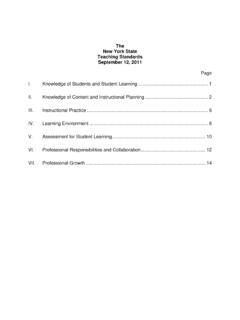Transcription of The Benefits and Challenges of Modular Higher Education ...
1 Issues and Ideas Paper The Benefits and Challenges of Modular Higher Education Curricula Dr Sarah French Melbourne Centre for the Study of Higher Education October 2015. Over the past twenty years, universities have increasingly employed credit-based Modular curriculum structures in an attempt to cater to the needs of more diverse student groups and to allow students greater flexibility and choice in managing their studies. Scholars generally agree that Modular degrees have many advantages for students in terms of their capacity to offer flexibility, choice, access and mobility. It is also widely argued that Modular structures may be beneficial to universities in that they potentially allow institutions to better respond to the needs of employers, expand student markets, develop more efficient uses of resources and increase opportunities for curricula breadth.
2 However, it is also argued that modularisation creates the possibility of fragmentation and incoherence of the educational experience, potentially weakens learning outcomes and comes with epistemological, structural and pedagogical Challenges . The topic of modularisation has featured prominently in scholarly literature in the field of Higher Education in the UK since the early 1990s but to date has received little attention in Australia. With the increasing pressures placed on Australian universities to better support teaching and learning while also creating greater efficiency, the possibility of adopting modularised course structures is likely to emerge as an issue facing Higher Education institutions in this country.
3 It is therefore timely and relevant to examine the possibilities and Challenges that modularisation presents. This paper outlines the background and rationale behind modularisation of university curricula and discusses both the potential Benefits and possible disadvantages of Modular course structures. It does not aim to make a case either for or against modularisation, but rather to provide a summary of the key arguments and an examination of some of the main issues, considerations and tensions that emerge in debates on the topic. Definition and background Modularisation is based on the general principle of dividing the curriculum into small discrete modules or units that are independent, non-sequential and typically short in duration.
4 Students accumulate credit for modules which can lead to a qualification for which a specified number of credit points is required. While there are vastly different types of Modular academic programs designed for different purposes, as well as different uses of terminology, Modular systems share an underlying philosophy that learning can be broken down into measurable, quantifiable units of knowledge. In contrast to a traditional linear degree program The Issues and Ideas Papers produced by the Melbourne CSHE explore contemporary trends and Challenges in Higher Education of relevance to the University of Melbourne and beyond.
5 The papers are designed to stimulate and support discussion of policy, practice and future directions. The Benefits and Challenges of Modular Higher Education Curricula Sarah French comprised of a sequence of subjects, modularised degrees tend to be made up of stand-alone, independent units that can be undertaken in different orders and accumulated at different speeds. Modularisation of the curriculum primarily refers to the disaggregation of the content of the curriculum rather than to a temporal metric. It constitutes a shift from a time-based to a credit-based structure. However, modularisation is also associated with the notion of delivering knowledge in bite-sized' pieces, and therefore lends itself to time- shortened and intensive modes of delivery.
6 The capacity for modularisation to provide learning and certification on demand in small packages is part of the reason for the popularity of online Modular courses such as MOOCs, however, the notion of obtaining micro-credits' for stand-alone modules is not limited to online study. Modularisation is sometimes conflated or confused with semesterisation yet the terms refer to different systems for dividing the curriculum. While modularisation is a content-based division, semesterisation is a time-based division that separates the academic year into two teaching periods. Modularisation and semesterisation can either operate concurrently or independently.
7 In the UK, some universities employing modularisation in the 1990s were less enthusiastic about semesterisation, preferring to teach short modules of approximately five weeks within ten-week trimesters (Rich & Scott, 1997). In contrast, Australian universities have predominantly adopted semesterisation but don't necessarily employ modularised curriculum structures. The Modular course generally stands in contrast to the notion of the traditional university subject.' For example, David Bridges argues that modularisation represents the deconstruction of the subject' and suggests that the practice signals a radical change to the identity of the subjects of the traditional Education curriculum' (2000:42).
8 Many view Modular structures as the antithesis to the traditional university curriculum since degrees are constructed from a series of discrete units rather than developed sequentially. An Issues Paper produced by the Australian Learning and Teaching Council suggests that the focus on isolated learning in single subjects' through modularisation contrasts sharply with the integrative learning possible with a whole-of-program approach' (the National GAP website). This paper is critical of modularisation, which it argues carries the need to teach and assess discrete components of learning, often to the exclusion of more integrative learning outcomes.
9 ' However, others contest the argument that modularisation necessarily results in isolated learning, suggesting that Modular structures can be used to design developmental courses that encourage a gradual and staged approach to learning (Hodgson &. Spours, 1997; Rich & Scott, 2011). Modularisation is an established feature of the Education system in the US where Modular course structures emerged over a century ago and credit-based systems have long been employed. Modular structures are also a feature of smaller Education systems in countries such as Scotland, Sweden and New Zealand (Hodgson & Spours, 1997: 107).
10 In the UK modularisation developed in the late 1980s and early 1990s as an institutionally-driven initiative that took place in most universities. For this reason, the vast majority of literature on modularisation emerged from the UK from the mid-1990s by which time the structuring of university degrees into credit-based Modular systems had become common practice. The implementation of Modular degrees dramatically altered the UK Education system and provoked a great deal of scholarly debate. In their book The Effective Academic, Fry, Ketteridge and Marshal observe that the widespread modularisation of the undergraduate (and increasingly, of the postgraduate) curriculum is perhaps the most remarkable change in the UK Higher Education and course design in the 20th century' (2002: 86).











